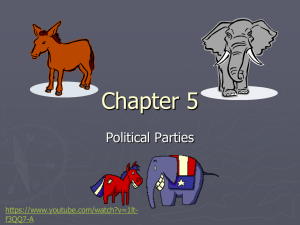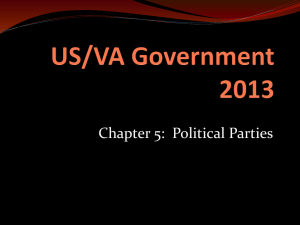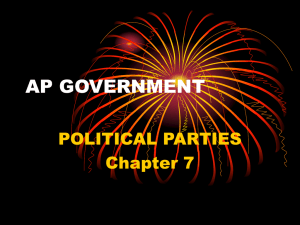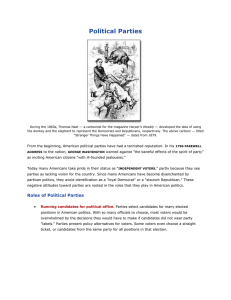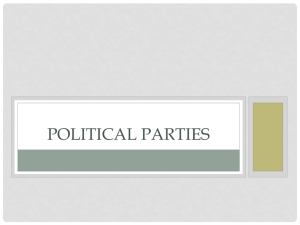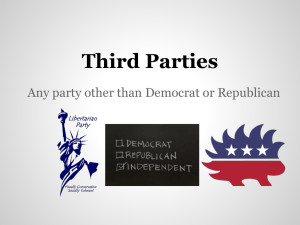Chapter 5
advertisement
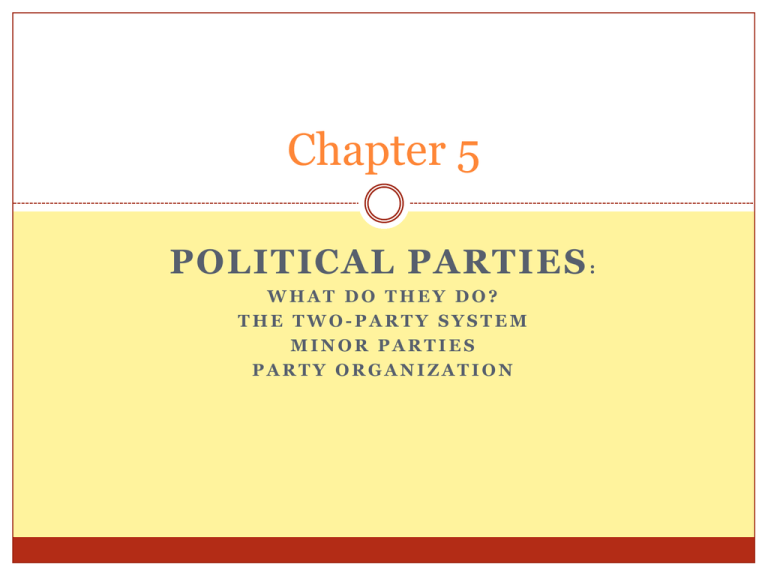
Chapter 5 POLITICAL PARTIES : WHAT DO THEY DO? THE TWO-PARTY SYSTEM MINOR PARTIES PARTY ORGANIZATION DO NOW: DEFINE THE VOCABULARY 1. 2. 3. 4. 5. 6. 7. 8. POLITICAL PARTY MAJOR PARTIES PARTIANSHIP MINOR PARTIES TWO-PARTY SYSTEM INCUMBENT FACTIONS ELECTORATE What do Parties do? Nominate Candidates 1. Select candidates to run for office Continuously searching and recruiting The nominating process is exclusively a political parties responsibility 2. Informing and Activating Support Inform through campaigning, taking a stand on issues and criticizing opponents Biased information educates public to its own advantage Goal of political parties is to win elections and hold office What do they do? 3. The Bonding Agent: Ensures good performance of its candidates & office holders Chooses candidates are of good character or at least that they are qualified to hold the office 4. Governing: Government is organized along party lines Appointments to offices are also made with party considerations What do they do? 5. Act as a Watchdog 5. Observe the conduct of the public’s business 6. Particularly true of the party out of power 7. Party out of power frequently criticizes the party in power 8. Party in power controls the executive branch at the national level The Two-Party System Traditionally, the US has had a two-party system – only the Republican or Democrat candidate has a reasonable change of winning. However, minor parties – a party without wide support Minor parties include: Green Party Independent Party Conservative Party Right to Life Party Libertarian Party Minor Parties Some minor parties limit themselves to a particular location or issue. Most are only short-lived. There are four types of minor parties: Ideological: based on a particular set of beliefs Built on a shade of Marxist thought ie: Socialist and Communist Parties Single-Issue: focus only on one public policy matter Their name usually indicates their concern Free Soil Party or Right to Life Party Economic Protest: rooted during periods of economic discontent Proclaim the disgust with the major parties and demand better times Disappear when conditions improve Splinter: split away from one of the major parties Most form around a strong personality Party fades when leader steps aside Party Organization Decentralized Parties Parties are fragmented and struggle with factions and internal squabbling (ie: Tea Party) There is no chain of command from National down to local party leadership Role of the President The President’s party is usually more united than that of the party out of office. He is automatically the leader of the party and creates lots of media attention to the Party. The Future of the Party Political Parties have been declining since the late 1960’s. There are several factors for this decline: Fewer votes identify themselves as one party or another Split-Ticket Voting: voting for candidates from different parties Structural changes and reform have made the parties more “open” but also create more conflict Changes in campaigning technology have made candidates less dependent on party organizers.
